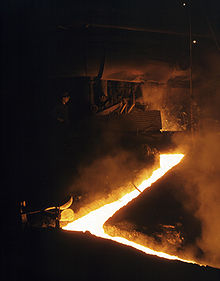Slag
Slag
A path through a slag heap in Clarkdale, Arizona, showing the striations from the rusting corrugated sheets retaining it.
The Manufacture of Iron – Carting Away the Scoriæ (slag), an 1873 wood engraving
Contents
Ore smelting
In nature, iron, copper, lead, nickel and other metals are found in impure states called ores, often oxidized and mixed in with silicates of other metals. During smelting, when the ore is exposed to high temperatures, these impurities are separated from the molten metal and can be removed. Slag is the collection of compounds that are removed. In many smelting processes, oxides are introduced to control the slag chemistry, assisting in the removal of impurities and protecting the furnace refractory lining from excessive wear. In this case, the slag is termed synthetic. A good example is steelmaking slag: quicklime and magnesite are introduced for refractory protection, neutralising the alumina and silica separated from the metal, and assist in the removal of sulfur and phosphorus from the steel.
Slag run-off from one of the open hearth furnaces of a steel mill, Republic Steel, Youngstown, Ohio, November 1941. Slag is drawn off the furnace just before the molten steel is poured into ladles for ingotting.
As the slag is channeled out of the furnace, water is poured over it. This rapid cooling, often from a temperature of around 2,600 °F (1,430 °C), is the start of the granulating process. This process causes several chemical reactions to take place within the slag, and gives the material its cementitious properties.
The water carries the slag in its slurry format to a large agitation tank, from where it is pumped along a piping system into a number of gravel based filter beds. The filter beds then retain the slag granules, while the water drains away and is returned to the system.
When the filtering process is complete, the remaining slag granules, which now give the appearance of coarse beach sand, can be scooped out of the filter bed and transferred to the grinding facility where they are ground into particles that are finer than Portland cement.
Ancient uses
Early slag from Denmark, c. 200-500 CE
Historically, the re-smelting of iron ore slag was common practice, as improved smelting techniques permitted greater iron yields—in some cases exceeding that which was originally achieved. During the early 20th century, iron ore slag was also ground to a powder and used to make agate glass, also known as slag glass.[2]
Modern uses
Ground granulated slag is often used in concrete in combination with Portland cement as part of a blended cement. Ground granulated slag reacts with water to produce cementitious properties. Concrete containing ground granulated slag develops strength over a longer period, leading to reduced permeability and better durability. Since the unit volume of Portland cement is reduced, this concrete is less vulnerable to alkali-silica and sulfate attack.[citation needed]This previously unwanted recycled product is used in the manufacture of high-performance concretes, especially those used in the construction of bridges and coastal features, where its low permeability and greater resistance to chlorides and sulfates can help to reduce corrosive action and deterioration of the structure.[3] The slag can also be used to create fibers used as an insulation material called slag wool.
Basic slag
Basic slag is a co-product of steelmaking, and is typically produced either through the blast furnace -- oxygen converter route or the electric arc furnace—ladle furnace route.[4] To flux the silica produced during steelmaking, limestone and/or dolomite are added, as well as other types of slag conditioners such as calcium aluminate or fluorspar. The major components of these slags therefore include the oxides of calcium, magnesium, silicon, iron, and aluminum, with lesser amounts of manganese, phosphorus, and others depending on the specifics of the raw materials used.Because of the slowly released phosphate content in phosphorus-containing slag, and because of its liming effect, it is valued as fertilizer in gardens and farms in steel making areas. However, the most important application is construction.[5]
See also
| Wikimedia Commons has media related to Slag. |
- Dross
- Fly ash
- Ground granulated blast furnace slag
- Mill scale
- Pozzolan
- Slag (welding)
- Spoil heap
- Tailings
References
Further reading
- Dimitrova, S.V. (1996). "Metal sorption on blast-furnace slag". Water Research. 30 (1): 228–232. doi:10.1016/0043-1354(95)00104-S.
- Roy, D.M. (1982). "Hydration, structure, and properties of blast furnace slag cements, mortars, and concrete". ACI Journal Proceedings. 79 (6).
- Fredericci, C.; Zanotto, E.D.; Ziemath, E.C. (2000). "Crystallization mechanism and properties of a blast furnace slag glass". Journal of Non-Crystalline Solids. 273 (1–3): 64–75. Bibcode:2000JNCS..273...64F. doi:10.1016/S0022-3093(00)00145-9.




Comments
Post a Comment